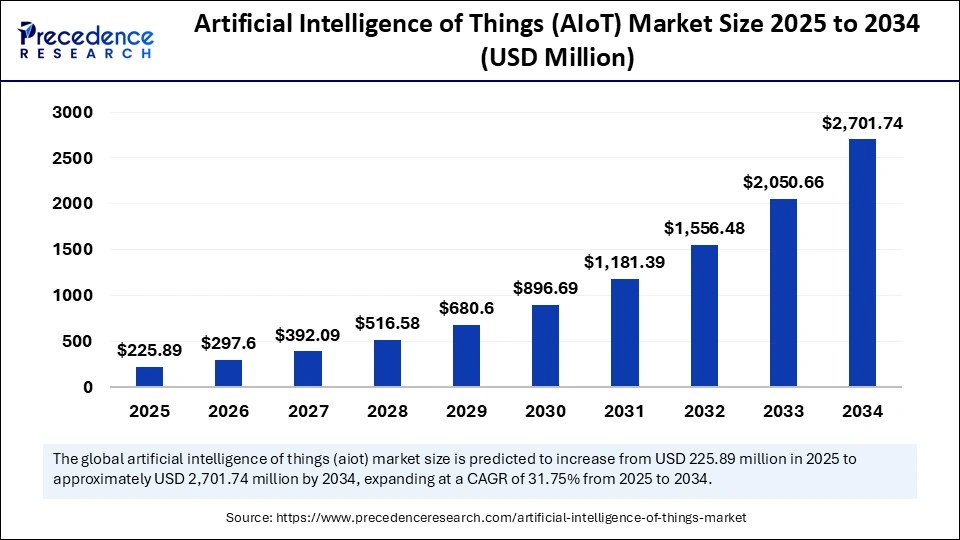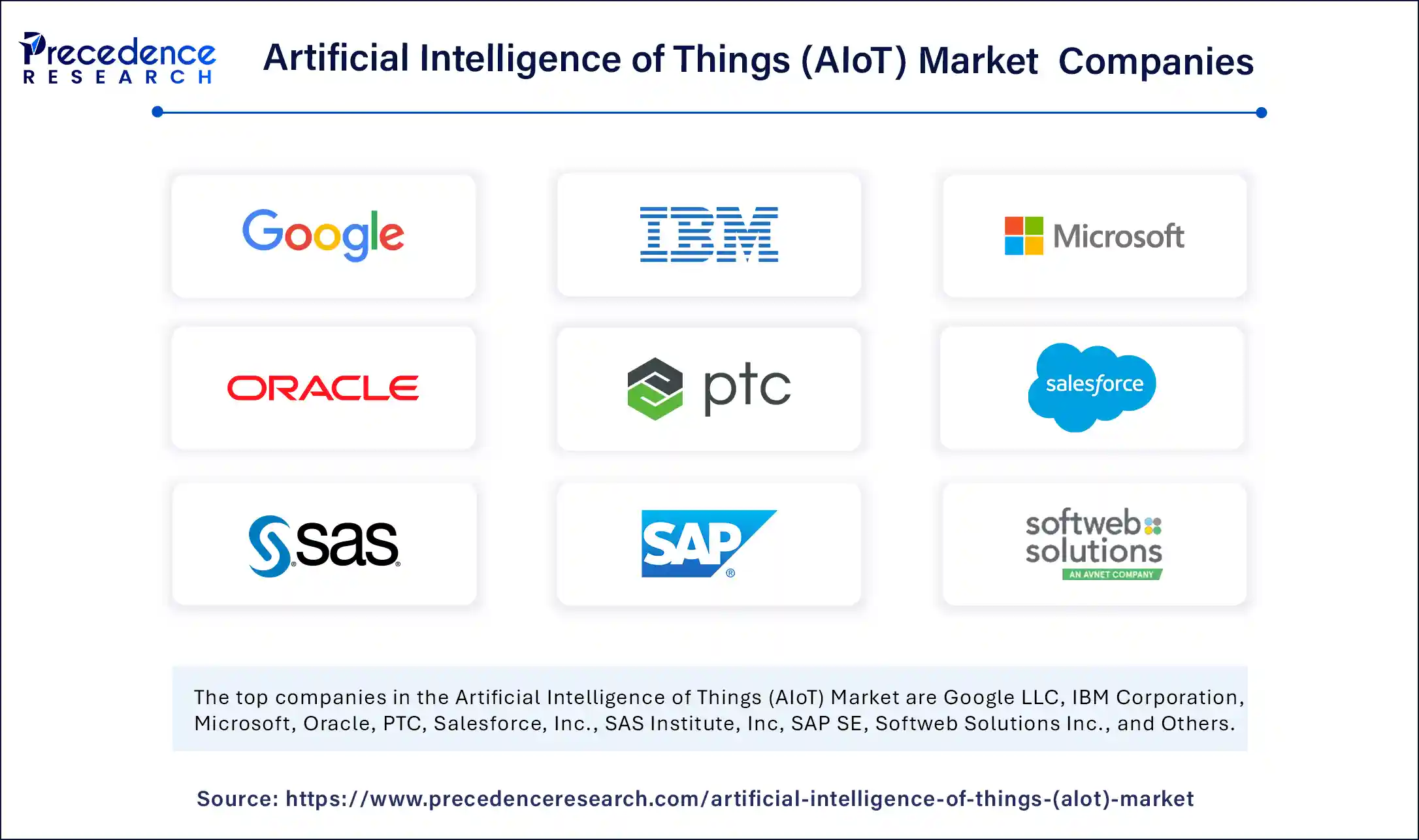
Artificial Intelligence of Things (AIoT) Market Key Points
-
North America led the global market with a 43% share in 2024.
-
Asia Pacific is projected to register the fastest growth in the coming years.
-
By component, the hardware segment dominated the market with a 62% share in 2024.
-
The services segment is expected to grow at the fastest CAGR over the forecast period.
-
In terms of application, the video surveillance segment captured the largest market share in 2024.
-
The predictive maintenance segment is anticipated to grow at the highest CAGR in the near future.
-
By deployment, the cloud segment accounted for 73% of the market share in 2024.
-
The on-premises segment is emerging as the fastest-growing deployment mode during the forecast period.
-
Based on end use, the B2B segment contributed the largest market share of 64% in 2024.
-
The B2G segment is forecasted to grow at the fastest CAGR through the projection period.
-
Among verticals, the manufacturing segment held a notable market share in 2024.
-
The healthcare segment is expected to expand at the highest CAGR over the forecast timeframe.
Artificial Intelligence of Things (AIoT) Market Overview
The Artificial Intelligence of Things (AIoT) market represents the powerful convergence of two transformative technologies: Artificial Intelligence (AI) and the Internet of Things (IoT). AIoT refers to the integration of AI capabilities into IoT devices and systems, enabling them to make autonomous decisions, learn from data patterns, and optimize operations without human intervention. While IoT focuses on connectivity and data generation from physical devices, AI empowers these devices with the ability to analyze, adapt, and act in real time.
The AIoT market is rapidly expanding across multiple sectors including manufacturing, healthcare, smart cities, transportation, agriculture, and retail. Smart sensors, edge computing, machine learning algorithms, and real-time analytics are at the heart of AIoT solutions that transform raw data into actionable intelligence. Enterprises are increasingly adopting AIoT to enhance operational efficiency, improve safety, enable predictive maintenance, and deliver personalized customer experiences. As the number of connected devices grows exponentially and data volumes surge, the need for intelligent, scalable AIoT architectures has never been more critical.
Artificial Intelligence of Things (AIoT) Market Growth Factors
The growth of the AIoT market is being driven by a combination of technological advances and market demand for intelligent automation. A key growth factor is the proliferation of IoT devices across industrial and consumer environments. With billions of sensors and connected systems generating continuous streams of data, organizations are looking to AI to make sense of this information and derive value from it.
Another strong catalyst is the advancement in AI technologies, particularly in deep learning, computer vision, and natural language processing, which allow machines to perform complex tasks such as image recognition, behavior prediction, and language translation. As these AI capabilities are embedded into edge and IoT devices, the resulting systems are more responsive and efficient.
Additionally, the rise of edge computing—processing data closer to the source rather than in centralized cloud servers—is accelerating AIoT deployment. Edge AI enhances latency, reduces bandwidth usage, and enables real-time decision-making, which is crucial in mission-critical applications such as autonomous vehicles, industrial robotics, and remote healthcare.
The market is also supported by strong enterprise and government investments in digital transformation initiatives, including smart manufacturing (Industry 4.0), intelligent transportation systems, and connected public infrastructure. These trends underscore the strategic importance of AIoT in driving innovation and productivity.
Impact of AI on the Artificial Intelligence of Things (AIoT) Market
AI plays a central role in enabling and expanding the potential of the AIoT market. By bringing intelligence to IoT, AI allows systems to learn from historical data, adapt to new inputs, and automate complex tasks, often in real time. This drastically improves the efficiency and functionality of connected systems.
One of the most significant impacts of AI is in predictive analytics and maintenance, where it helps forecast equipment failures and optimize maintenance schedules, thereby reducing downtime and operational costs. AI also improves anomaly detection, helping identify unusual patterns or behavior across large-scale sensor networks, which is critical for cybersecurity and quality assurance.
In addition, AI enables context-aware decision-making by analyzing environmental, behavioral, and situational data. For example, smart traffic systems can adapt signal timings based on real-time traffic flow, and smart buildings can adjust lighting and HVAC systems based on occupancy and weather conditions.
AI’s integration into AIoT platforms also facilitates automated learning and optimization, where the system continuously evolves based on usage patterns and external conditions. In consumer applications, this results in highly personalized experiences—such as smart home assistants learning user preferences—while in industrial applications, it leads to improved safety, efficiency, and scalability.
Market Scope
| Report Coverage | Details |
| Market Size by 2034 | USD 2,701.74 Million |
| Market Size in 2025 | USD 225.89 Million |
| Market Size in 2024 | USD 171.45 Million |
| Market Growth Rate from 2025 to 2034 | CAGR of 31.75% |
| Dominating Region | North America |
| Fastest Growing Region | Asia Pacific |
| Base Year | 2024 |
| Forecast Period | 2025 to 2034 |
| Segments Covered | Component, Application, Deployment, End Use, Vertical, and Region |
| Regions Covered | North America, Europe, Asia-Pacific, Latin America, and Middle East & Africa |
Market Drivers
- Rising demand for automation and intelligent decision-making across sectors such as manufacturing, logistics, and healthcare.
- Explosion of IoT devices and data, necessitating scalable, AI-driven platforms to process and interpret vast amounts of information in real time.
- Growth of edge computing and 5G connectivity, which support low-latency, high-bandwidth, and distributed AIoT applications.
- Increased investment in smart infrastructure and smart city initiatives, where AIoT enables energy management, surveillance, waste management, and mobility solutions.
- Consumer adoption of smart devices, such as wearables, voice-controlled assistants, and connected appliances, driving the AIoT momentum in the home automation space.
Opportunities
The AIoT market presents numerous opportunities for growth, innovation, and disruption. One major opportunity lies in the development of AIoT solutions for industrial automation (IIoT). By deploying AI-powered sensors and predictive algorithms, factories can achieve self-optimizing production lines, improve product quality, and reduce energy consumption.
Another emerging opportunity is in healthcare AIoT, where wearable devices and remote monitoring systems powered by AI can track patient vitals, detect anomalies, and support telemedicine initiatives. This is particularly relevant in aging populations and rural areas where access to healthcare is limited.
Agriculture is another sector poised for AIoT transformation. Smart farming solutions that combine AI and IoT can optimize irrigation, monitor crop health, and predict yield outcomes, helping increase food production while reducing resource usage.
In addition, the retail and logistics sectors stand to benefit from AIoT-driven supply chain optimization, personalized marketing, and inventory management. AIoT platforms can track goods in real time, forecast demand, and improve last-mile delivery.
Challenges
Despite its promising trajectory, the AIoT market faces several significant challenges. Data privacy and security concerns top the list, as the widespread deployment of connected devices increases the attack surface for cyber threats. Protecting sensitive data and ensuring secure communications is critical for enterprise and consumer trust.
High implementation costs and technical complexity also pose barriers, particularly for small and medium-sized businesses. The integration of AI models with legacy IoT infrastructure and heterogeneous devices can be difficult and costly.
Another challenge is the lack of standardization across AIoT platforms, which hinders interoperability and scalability. Fragmented ecosystems can result in vendor lock-in and limit the ability to share data across devices and systems.
Furthermore, the shortage of skilled professionals in both AI and IoT fields can slow down development and deployment efforts. Effective AIoT implementation requires expertise in hardware, software, data science, and cybersecurity, making talent acquisition a significant hurdle.
Regional Outlook
North America leads the global AIoT market, driven by strong technological innovation, advanced industrial automation, and robust investments in AI startups and digital infrastructure. The U.S. is home to many of the world’s leading AI and IoT solution providers, and government-backed smart city and defense initiatives continue to propel growth.
Europe follows closely, with countries like Germany, France, and the UK pushing ahead with Industry 4.0 initiatives, sustainable energy management, and connected public services. The European Union’s focus on data privacy and AI regulation also shapes the development of secure and ethical AIoT solutions.
Asia Pacific is expected to witness the fastest growth, fueled by large-scale digital transformation, rapid urbanization, and manufacturing modernization in countries such as China, India, Japan, and South Korea. Government initiatives like China’s “New Infrastructure” policy and India’s Smart Cities Mission are catalyzing large-scale AIoT deployment across sectors.
Latin America, the Middle East, and Africa are emerging markets for AIoT, with growing investments in smart agriculture, infrastructure development, and renewable energy. However, limited connectivity, infrastructure gaps, and regulatory uncertainty may pose short-term adoption barriers.
Artificial Intelligence of Things (AIoT) Market Companies

- Google LLC
- IBM Corporation
- Microsoft
- Oracle
- PTC
- Salesforce, Inc.
- SAS Institute, Inc
- SAP SE
- Softweb Solutions Inc.
- Thingstel Tech Solutions India Pvt Ltd
Segments Covered in the Report
By Component
- Hardware
- Software
- Services
By Application
- Video Surveillance
- Inventory Management
- Predictive Maintenance
- Supply Chain Management
- Others
By Deployment
- Cloud
- On-Premises
By End Use
- B2B
- B2G
- B2C
By Vertical
- Retail
- Agriculture
- Logistics
- BFSI
- Automotive
- Healthcare
- Manufacturing
- Others
By Region
- North America
- Europe
- Asia Pacific
- Latin America
- MEA
Read Also: Security and Vulnerability Management Market
Get this report to explore global market size, share, CAGR, and trends, featuring detailed segmental analysis and an insightful competitive landscape overview @ https://www.precedenceresearch.com/sample/6261
You can place an order or ask any questions, please feel free to contact at sales@precedenceresearch.com|+1 804 441 9344